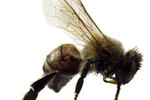
You may imagine a southern wasp spends her time sitting on the porch drinking sweet tea and attending church regularly. It isn't easy to determine their religious leanings, but this description is surprisingly accurate when it comes to the southern yellow jacket wasp (Vespula squamosa). They're often found sampling food and beverages near human habitations in the summer heat, their time of greatest activity.
What's in a Name?
Wasps are members of order Hymenoptera along with ants, bees and sawflies. The wasp family is Vespidae. Hornets and yellow jackets are specific groups of short-bodied, omnivorous wasps with powerful stings. They're classified by nesting habit: Yellow jackets typically build nests below ground, hornets from high places.
Group Living
Wasp life span has two separate components: the life span of the colony, and that of individuals. Except in the warmest frost-free climates, southern yellow jacket colonies live from the spring thaw until autumn's first hard frost. The life spans of wasps within a colony vary dramatically depending on the individual's social caste.
Social Classes
Southern yellow jacket wasp colonies have four classes of individuals: founding queen, workers, males and new queens. Founding queens are pregnant queens from the prior year -- the only ones that survive winter. Their first fertile eggs become sterile female workers. After these hatch, the queen stays home for the rest of her life. Workers spend their lives raising future batches of wasps, all of whom are children of the founding queen. Near the end of summer the queen lays fertile eggs that become new queens and unfertilized haploid eggs that become males.
Labor-Saving Innovation
A founding queen's first several weeks post-hibernation are fraught with frenzied activity. She must find a suitable nest site, build the first brood combs from chewed wood pulp, lay eggs, hunt down food and process it, defend the nest and carefully tend larvae for around 30 days until they mature. Vespula squamosa developed a time-saving device to reduce this workload: Founding queens find the brood combs of neighboring species -- especially eastern yellow jackets (Vespula maculifrons) -- and insert their own young inside, driving off their close relatives. This behavior is extremely widespread but not universal and may be an adaptation to colder regions, with their greater time constraint on colony life spans.
Unexpected Exchanges
Southern wasp workers carry off all manner of food, from other insects they've hunted and killed to your fried chicken and cake. However, it isn't for themselves. They chew it to a fine paste and feed it to the colony's growing larvae. Surprisingly, the larvae return the favor: Juvenile wasps produce a nectarlike substance, which they feed back to the adult wasps ... but this strangely tender interplay is doomed to end with the change of seasons.
Decline of Civilization
After new queens and males hatch in the fall, they take off on nuptial flights. Lucky ones mate. Successful new queens drop to the ground and head off, seeking safe places to hibernate for the winter. Unsuccessful new queens and all males drop dead. As the temperature drops, the founding queen dies. Her loss throws the workers into chaos. Her sterile daughters wander off and die, and the last hapless larvae are orphaned or abandoned, left to be eaten by scavengers.
References
- Canadian Journal of Arthropod Identification: Vespula Squamosa - Southern Yellowjacket
- Journal of the Kansas Entomological Society: Nesting Biology of the Southern Yellowjacket, Vespula squamosa (Hymenoptera: Vespidae) - Social Parasitism and Independent Founding
- Clemson University Cooperative Extension: Yellow Jackets
- BugGuide.net: Species Vespula Squamosa - Southern Yellowjacket
- University of Florida Entomology and Nematology Department: Yellowjackets and Hornets
- Adkins Bee Removal: Wasp Identification Chart
- Texas A&M University Extension: Southern Yellowjacket
Photo Credits
-
Hemera Technologies/Photos.com/Getty Images
Writer Bio
Angela Libal began writing professionally in 2005. She has published several books, specializing in zoology and animal husbandry. Libal holds a degree in behavioral science: animal science from Moorpark College, a Bachelor of Arts from Sarah Lawrence College and is a graduate student in cryptozoology.



